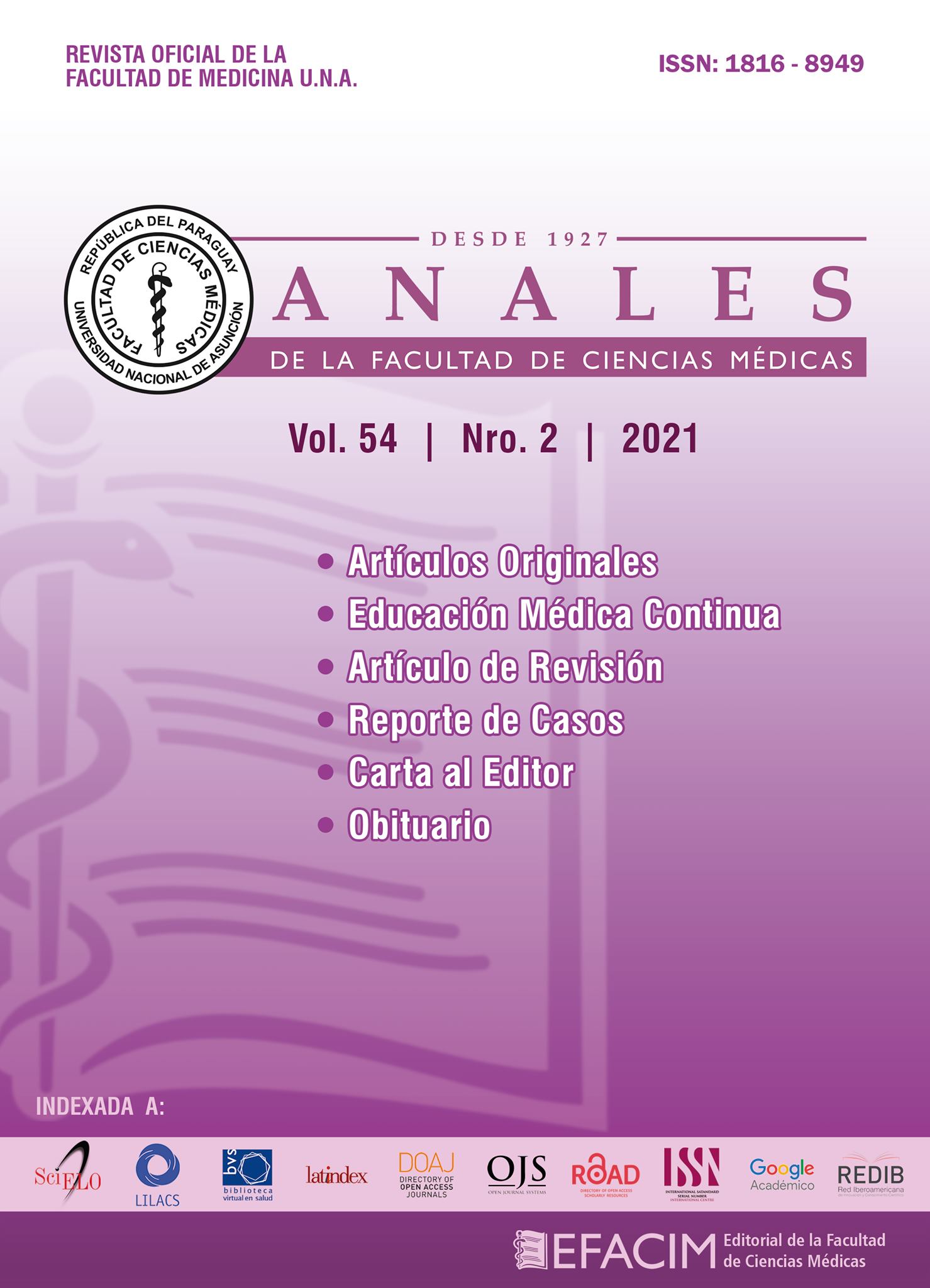Exactitud de las fórmulas de cálculo del poder de Lente Intraocular en Cirugía de Cataratas. Comparación de 8 fórmulas
Palabras clave:
Extracción de catarata, Implantación de Lente Intraocular, Pseudofaquia, BiometríaResumen
Introducción: La cirugía de cataratas tiene como objetivo restablecer la función visual comprometida
por la opacificación del cristalino; con el implante del Lente Intraocular se pretende obtener la
mejor agudeza visual posible sin corrección adicional. Objetivos: Comparar la exactitud de 8
fórmulas de cálculo de Lentes Intraoculares en la predicción de la refracción postoperatoria con
un único dispositivo de biometría óptica en pacientes operados de cirugía de catarata con técnica
de facoemulsificación. Materiales y métodos: Serie de casos consecutivos retrospectivos. 100
pacientes fueron sometidos a cirugía de catarata no complicada con de Lente Intraoculares por
un único cirujano; del 1 mayo del 2017 al 1 de mayo del 2018; donde la cirugía fue realizada por
córnea clara facoemulsificación. En el período preoperatorio todos los pacientes fueron medidos
con biometría óptica. La refracción manifiesta se obtuvo al mes de realizada la cirugía. Resultados:
La fórmula más precisa y con mejor desempeño general fue PANACEA con un DRA de 0,18 D;
cuando consideramos ojos cortos y largos la fórmula Barrett Universal 2 obtuvo menor error de
predicción. HAIGIS y LADAS obtuvieron el mejor desempeño en ojos con cámaras estrechas y
profundas respectivamente. Conclusión: No se encontraron diferencias en el defecto refractivo
absoluto entre las fórmulas tradicionales de tercera generación y las de reciente desarrollo. Algunas
fórmulas tuvieron mejor desempeño al considerar ciertas características anatómicas particulares. Es
importante personalizar la elección de la fórmula para cada caso específico.
Referencias
Haigis W. Challenges and approaches in modern biometry and IOL power calculation. Saudi Journal of Ophthalmology 2012; 26: 7–12
Olsen T. Calculation of intraocular lens power: a review. Acta Ophthalmol Scand 2007; 85:472–485.
Buckhurst, P. J., Wolffsohn, J. S., Shah, S., Naroo, S. A., Davies, L. N., & Berrow, E. A new optical low coherence reflectometry device for ocular biometry in cataract patients. Br J Ophthalmol 2009;93:949–953
Norrby S. Sources of error in intraocular lens power caculation. J Cataract Refract Surg 2008; 34:368–376
Gokce S, Zeiter J, Weikert M, Koch D, Hill W, Wang Li. Intraocular lens power calculations in short eyes using 7 formulas. J Cataract Refract Surg. J Cataract Refract Surg 2017; 43:892–897
Kane JX, Van Heerden A, Atik A, Petsoglou C. Intraocular lens power formula accuracy: comparison of 7 formulas. J Cataract Refract Surg. 2016;42:1490-1500.
Cooke DL, Cooke TL. Comparison of 9 intraocular lens power calculation formulas. J Cataract Refract Surg. 2016;42:1157- 1164.
Aristodemou P, Knox Cartwright NE, Sparrow JM, Johnston RL. Formula choice: Hoffer Q, Holladay 1, or SRK/T and refractive outcomes in 8108 eyes after cataract surgery with biometry by partial coherence interferometry. J Cataract Refract Surg. 2011;37:63-71.
Retzlaff JA SD, Kraff MC. Development of the SRK/T intraocular lens implant power calculation formula. J Cataract Refract Surg. 1990;16:333-40.
Haigis W. Occurrence of erroneous anterior chamber depth in the SRK/T formula. J Cataract Refract Surg. 1993;19(3):442-6.
Sheard RM, Smith GT, Cooke DL. Improving the prediction accuracy of the SRK/T formula: the T2 formula. J Cataract Refract Surg. 2010;36(11):1829-34
Holladay JT, Prager TC, Chandler TY, Musgrove KH, Lewis JW, Ruiz RS. A three-part system for refining intraocular lens power calculations. J Cataract Refract Surg.1988;14(1):17-24.
Hoffer KJ. The Hoffer Q formula: a comparison of theoretic and regression formulas. J Cataract Refract Surg. 1993;19(6):700-12.
Haigis W. The Haigis Formula. in Shammas HJ, editor. Intraocular power calculations. New Jersey: SLACK Incorporated; 2003. p 41-57.
Hill W.E. IOL Power Selection by Pattern Recognition; CRST Europe [Internet]. 2016 [consultado 12 de abril de 2019]. 10 (11) 143-146. Disponible en https://crstodayeurope.com/articles/new-frontiers-in-iol-prediction-for-improved-refractive-outcomes/iol-power-selection-by-pattern-recognition/?toc=true
Ladas JG, Siddiqui AA, Devgan U, Jun AS. A 3-D “super surface” combining modern intraocular lens formulas to generate a “super formula” and maximize accuracy. JAMA Ophthalmol. 2015;133:1431-1436.
Barrett G. An improved universal theoretical formula for intraocular lens power prediction. J Cataract Refract Surg 1993; 19 (11); 713:720
Flikier D. Panacea: La forma sencilla de entender la Biometria Avanzada. 22 de febrero de 2017. Academia Panamericana de Oftalmología. [consultado 12 de abril de 2019]. Disponible en: https://www.campuspaao.org/enrol/index.php?id=93.





